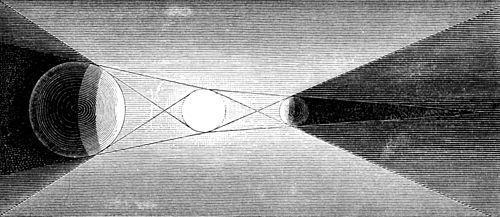body is completely screened from the rays. The cone thus constructed is called the shadow-cone, and its intersection with any surface behind the opaque body defines the shadow cast upon that surface. In the case which we have been supposing—that of a luminous point—the shadow-cone and the shadow itself will be sharply defined."
Actual sources of light are not, however, mere points; they have finite and variable dimensions, and this complicates the effect in the geometry of shadows. These effects are well illustrated by the diagram (Fig. 7). Let the central sphere represent a source of light placed between two opaque spheres, one larger and the other smaller than itself. We shall then have two kinds of shadow, the total shadow or umbra, and the partial shadow or penumbra. If the opaque sphere, seen at the right in the diagram, be smaller than the luminous body, the umbra terminates at a finite distance depending upon the relative magnitudes and the proximity of the two bodies. If the opaque body is larger than the source of illumination, as illustrated in the left portion of the diagram, the cone of the umbra is projected to an infinite distance. The penumbral cones represented
Fig. 7.

Umbra and Penumbra.
by a lighter shading, it is seen, are wider than the cones of total shadow, and include them. It will be noticed that all points lying within the penumbral cones are excluded from the view of some portion of the luminous body, and are thus partially shaded by the opaque bodies. Points that are very near the outer boundaries are very slightly darkened, if near the total shadow they are almost completely shaded. The penumbra is, therefore, not a uniform shadow, but gradually fades into darkness from its outer limit to the total obscuration of the umbra. It follows from this that the shadow of an opaque body falling upon a screen will not have a sharply-defined edge, but will show a transition from total shadow to the complete absence of shadow. To have the shadow clean and sharp at its edge,

